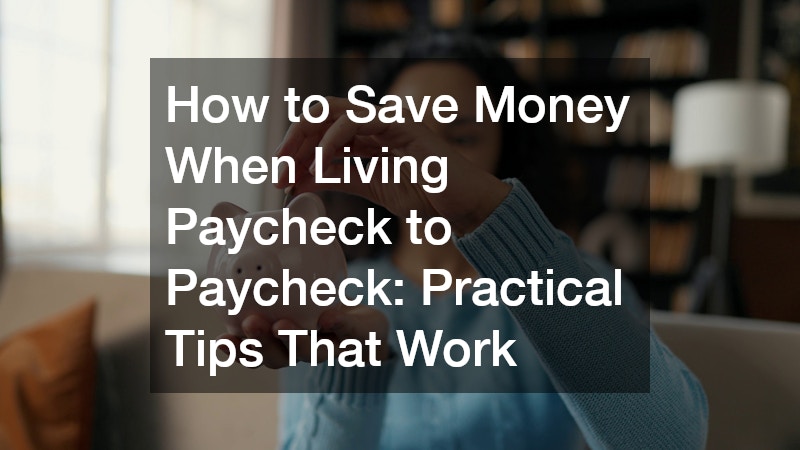
For many people, living paycheck to paycheck is more than just a financial challenge—it’s a constant source of stress. Even when you work hard, it can feel like money slips through your fingers before you have a chance to save. But the truth is, small, strategic changes can help you regain control of your finances, reduce stress, and start putting money aside for the future.
In this guide, we’ll explore practical ways to save money even if your income barely covers your monthly expenses. No gimmicks, no overnight miracles—just realistic strategies that can work for anyone.
Why Is Saving So Hard Right Now?
When money is tight, saving often feels impossible. But the difficulty usually comes from a mix of invisible leaks and predictable expenses. Understanding these obstacles is a key first step in learning how to stop living paycheck to paycheck.
Some common reasons you might struggle to save:
- Unexpected bills: Car repairs, medical costs, or home fixes can wipe out extra cash.
- Everyday spending adds up: Daily coffee runs, online shopping, or takeout may seem minor but add up fast.
- No visibility on your money: If you don’t track income and expenses, it’s easy to overspend.
Understanding the real reasons behind your tight budget helps you focus on realistic ways to save.
Where Can You Cut Costs Without Feeling Deprived?
Saving money doesn’t have to mean sacrificing everything you enjoy. By making thoughtful adjustments and prioritizing what truly matters, you can free up funds while still maintaining a comfortable lifestyle. Here’s how to approach it:
1. Groceries
Food is one of the largest monthly expenses for most households, but there are plenty of ways to save without giving up quality meals:
- Plan your meals: Create a weekly menu and make a shopping list based on it. This reduces impulse buys and waste.
- Buy in bulk: Items like rice, pasta, and canned goods are often cheaper in larger quantities.
- Use store brands: Many store-brand products have the same quality as name brands at a fraction of the cost.
- Cook at home more often: Preparing meals at home is almost always cheaper than eating out. Simple changes like making lunches instead of buying takeout can save hundreds each month.
2. Subscriptions
Recurring services can quietly drain your budget. Take time to review what you’re paying for:
- Audit streaming services, apps, or memberships: Cancel those you rarely use or switch to a cheaper plan.
- Share plans responsibly: Some subscriptions, like streaming or software, allow family or household sharing—split costs with friends or family.
- Set reminders: Mark renewal dates on your calendar to decide whether a subscription is still worth it.
3. Utilities and Bills
Small changes can lead to noticeable savings on everyday bills:
- Reduce energy usage: Turn off lights when not in use, unplug devices, and switch to energy-efficient bulbs and appliances.
- Conserve water: Fix leaks promptly, take shorter showers, and run washing machines or dishwashers only when full.
- Negotiate with providers: Call your internet, phone, or insurance companies and ask if they can offer a lower rate or bundle services.
4. Transportation
Transport costs often eat a big chunk of monthly income, but there are ways to cut without losing convenience:
- Walk or bike for short trips: Saves fuel and keeps you active.
- Carpool or use public transport: Reduces commuting costs significantly.
- Downsize or delay car upgrades: Avoiding a new car purchase or choosing a more fuel-efficient model can lower monthly expenses.
5. Everyday Small Expenses
Even tiny changes add up over time:
- Brew coffee at home instead of buying it daily.
- Pack snacks or lunches instead of spending on vending machines or convenience stores.
- Look for free or low-cost entertainment options—parks, local events, or online resources.
By approaching spending with intention, you can cut costs gradually without feeling deprived, freeing up money for savings or debt repayment.
How Can You Track Your Spending Effectively?
Before you can save, you need to see exactly where your money goes. Tracking doesn’t have to be overwhelming.
- Apps and tools: Mint, PocketGuard, or YNAB automatically categorize expenses.
- Simple spreadsheets: List income versus fixed and variable costs to spot patterns.
- Manual journaling: Write down every purchase, even small ones, to get a true picture.
Once you know your spending patterns, you can identify which habits to tweak.
Is a Budget Really Necessary?
A budget isn’t about restriction—it’s about control. When money is limited, a realistic plan prevents overspending and stress.
Tips for building a workable budget:
- Break spending into categories: essentials, flexible needs, discretionary.
- Set aside a small amount for savings each paycheck—even $10 counts.
- Adjust monthly as expenses or income fluctuate.
The goal isn’t perfection—it’s awareness and consistency.
Can You Save Even With Debt?
Living with debt can make it feel like saving is impossible. High-interest payments and multiple obligations can eat up your monthly income, leaving little room for building a financial cushion. But the truth is, even while paying off debt, it’s possible to save—especially if you approach your debt strategically.
1. Prioritize High-Interest Debts First
High-interest debt, such as credit cards or payday loans, can grow quickly if left unmanaged. Focusing on paying these off first saves money in the long run:
- List all your debts with balances and interest rates.
- Direct extra funds toward the debt with the highest interest while making minimum payments on others.
- As the high-interest debt decreases, you’ll free up cash that can be redirected to savings or other debts.
2. Use a Structured Repayment Strategy
Two popular methods can help you stay organized and motivated:
- Debt Avalanche Method: Pay off debts with the highest interest rates first, which reduces the total interest you pay over time. Best for those looking to save money efficiently.
- Debt Snowball Method: Pay off the smallest balances first, creating quick wins that boost motivation and build momentum.
Choose the method that aligns with your personality and keeps you consistent.
3. Explore Consolidation or Balance Transfers
Simplifying debt can reduce stress and make repayment more manageable:
- Balance transfer credit cards: Moving high-interest credit card debt to a card with 0% introductory APR can give you breathing room to pay down the balance faster.
- Debt consolidation loans: Combining multiple debts into one loan with a lower interest rate can reduce monthly payments and simplify your financial life.
- Negotiate rates with lenders: Contact credit card companies or lenders to ask for lower interest rates—many are willing to adjust if you have a good payment history.
4. Continue Small Savings While Paying Debt
Even while tackling debt, it’s important to keep some money going toward savings:
- Start with a tiny emergency fund ($500–$1,000) to cover minor unexpected costs, so you don’t rely on credit cards.
- Automate small transfers into a savings account, even if it’s just $10–$20 per week. This creates a habit and slowly builds a financial buffer.
5. Monitor Progress Regularly
Tracking your payments and savings helps you stay motivated:
- Review debt balances and interest charges monthly.
- Celebrate milestones, like paying off a small loan or reducing a credit card balance by a set amount.
By gradually lowering debt while maintaining even modest savings, you free up more money for financial goals, reduce stress, and build the foundation for long-term stability.
How Can You Increase Your Income Without a Major Career Change?
Sometimes cutting costs isn’t enough. Boosting income can create more breathing room.
- Take on freelance work, tutoring, or side gigs.
- Sell unused items around your home.
- Consider overtime or part-time opportunities that fit your schedule.
Even modest additional income, consistently applied to savings or debt repayment, adds up over time.
What About Mindful Spending?
Mindful spending is about making intentional choices instead of reacting impulsively.
- Pause before buying non-essential items. Ask if it’s truly necessary.
- Focus on purchases that bring real value or joy.
- Celebrate small wins to keep motivation high.
Shifting your mindset from “buy now” to “think first” can significantly improve your financial habits.
How to Save Money When Living Paycheck to Paycheck by Starting Small
Saving doesn’t need to be dramatic. Even minor, consistent actions can build momentum:
- Automate small transfers into a savings account.
- Use cashback apps or rewards programs to stretch dollars further.
- Apply windfalls—tax refunds, bonuses, or side gig income—directly to savings.
Over time, these small steps create a cushion that reduces stress and prepares you for emergencies.
Final Thoughts: Change is Gradual But Possible
Breaking the paycheck-to-paycheck cycle isn’t about overnight miracles—it’s about steady, sustainable habits. Track your spending, reduce costs thoughtfully, manage debt strategically, and look for income opportunities. With patience and consistency, even small changes can lead to meaningful financial freedom.
The key takeaway: start with what you can control today. Tiny, deliberate choices add up faster than you might expect—and over time, they can completely transform your financial situation.


